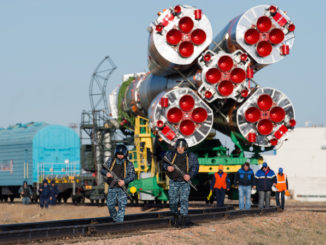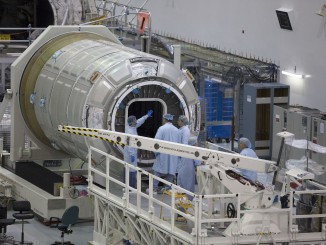
Russian cosmonauts Alexander Misurkin and Anton Shkaplerov floated outside the International Space Station on Friday and installed an upgraded electronics box on a high-gain communications antenna at the aft end of the Zvezda service module.
The spacewalking duo opened the hatch to the Russian Pirs airlock at 1534 GMT (10:34 a.m. EST) Friday to begin the planned six-and-a-half hour excursion.
But the work took longer than expected, and Misurkin and Shkaplerov finally returned to the Pirs airlock and closed the hatch at 2347 GMT (6:47 p.m. EST), closing out Friday’s spacewalk at a duration of 8 hours, 13 minutes.
That made Friday’s spacewalk the longest in the history of Russia’s space program, and the fifth-longest ever.
A Russian ground controller radioed an update on the spacewalk time shortly before the cosmonauts closed the hatch.
“We haven’t reached a record time for a spacewalk, have we?” one of the cosmonauts replied.
“The record time was 8:07,” someone answered from Russia’s mission control center near Moscow.
“Are you kidding us? I thought it was nine hours or so?”
“No, I’m talking from hatch opening to hatch closing,” the mission controller said. “That’s what we consider the EVA (extravehicular activity) time.”
Wearing Orlan spacesuits, Misurkin and Shkaplerov headed for a worksite at the aft end of the Zvezda service module, near the command post’s rear docking port, after leaving the Pirs airlock to begin the spacewalk. That location is home to the Lira high-gain antenna used to transmit data between the station’s Russian segment and Russian ground controllers near Moscow.
The cosmonauts removed numerous electrical connectors, transmission lines and bolts to disengage an old electronics box on the antenna, which was folded into its stowed position and was not intended to be serviced in orbit. The two spacewalkers then installed a new, upgraded electronics package to enable wideband communications through the Lira antenna via Russia’s Luch satellite data relay network.

The Lira antenna and its old electronics system launched with the Zvezda service module in July 2000. But Russia’s Luch satellite fleet, similar to NASA’s Tracking and Data Relay Satellite System, was in disrepair and unable to provide message relay services to the space station.
Russia launched three new Luch satellites between 2011 and 2014 with S-band and Ku-band communications capability, but the electronics equipment on the station’s Lira antenna was outdated and in need of an upgrade to be fully compatible with the Luch spacecraft.
Russian ground controllers currently keep in contact with the space station’s Russian segment through a patchwork of ground stations or via NASA’s satellite relay network.
Misurkin released the old Lira electronics box, with a mass of approximately 60 pounds (27 kilograms), on a retrograde trajectory behind the space station’s Zvezda module. Engineers say the box will not present a hazard to the space station, and it is expected to burn up when it re-enters the atmosphere.
The only major hitch on Friday’s spacewalk came when Russian ground controllers tried to command the Lira antenna to rotate back to its operational position after the electronics box swap. The antenna boom was snagged on equipment previously used to help guide the now-retired European Automated Transfer Vehicle supply ships toward dockings with the Zvezda module.
Misurkin and Shkaplerov helped clear the impediment, and engineers again commanded the antenna to move, but the boom rotated beyond its normal location. Russian will analyze data to confirm the antenna’s new position is acceptable.
“We rotated a lot of wing nuts, and I can feel it right now,” one of the spacewalkers said of their work as the excursion drew to a close.
Friday’s spacewalk was the fourth for Misurkin, who has now logged 28 hours and 14 minute of spacewalking time on his excursions outside the International Space Station. Shkaplerov completed his second spacewalk, and his logbook now shows 14 hours, 28 minutes, outside the research complex.
The cosmonauts completed a photographic survey of the Russian segment’s exterior before re-entering the Pirs airlock.
The spacewalk was the 44th from the Russian segment of the International Space Station, and the 207th spacewalk overall in support of space station assembly and maintenance.
Friday’s spacewalk was sandwiched between two EVAs outside the U.S. section of the space station.
Astronauts Mark Vande Hei and Scott Tingle completed a spacewalk Jan. 23 to replace a latching hand on the lab’s Canadian-built robotic arm. Vande Hei and Japanese flight engineer Norishige Kanai are scheduled to head outside for another spacewalk Feb. 15 to bring a faulty robotic hand, or end effector, back inside the space station for eventual return Earth inside a SpaceX Dragon capsule.
Email the author.
Follow Stephen Clark on Twitter: @StephenClark1.



